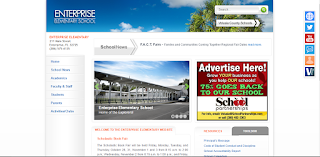As technology has evolved, many schools have incorporated it in to their classrooms. Additionally, schools have also begun to use technology to promote their schools and get in touch with their community outside of the classroom. This can be done through websites.
I visited the website of my mother's elementary school, Enterprise Elementary School. I could not access classrooms' websites specifically but there was a vast number of different links, found through easily navigating the sites under the name "Elementary Curriculum". Publicly, website-goers can access links about things going on in the community, teacher information, and a number of other things. It seems that any question a parent may have about the school that isn't classroom specific can be answered.
Here are two images. The first is the homepage and the second is the list of links provided when you click on the link entitled "Elementary Curriculum".
I plan to use technology in a similar way. I want to use technology for good, as an avenue that connects myself and my students to the real world. In the podcasts it describes professional development as the concept of people in a profession further their knowledge. Chapter 7 in our textbook provides a number of different ways one can further their knowledge through technology. This coupled with my desire to use technology to better myself and students will foster professional development and student growth. I envision myself using the many features of Microsoft Word that we have learned to better reach my students both within and beyond the classroom. Making quizzes and tests and letters to parents have all been made easier through discovering the different features offered by Microsoft Office.
Still along the lines of technology, our class visited the Tech Sandbox! This was beyond a shadow of a doubt one of the coolest things I have done all semester. We explored a ton of different technologies found in classrooms and each and every one was unbelievably engaging and fun. I have found that the importance of extracurricular learning and fun (recess) is being forgotten in schools. However, if I incorporate, say, the 3D pen into my classroom, students not only get to learn about that kind of technology, but they also get to have fun and make beautiful crafts in the process. I believe that developing a child's creativity is just as, if not more important than textbook learning. This technology allows students to experience the best of both worlds!


